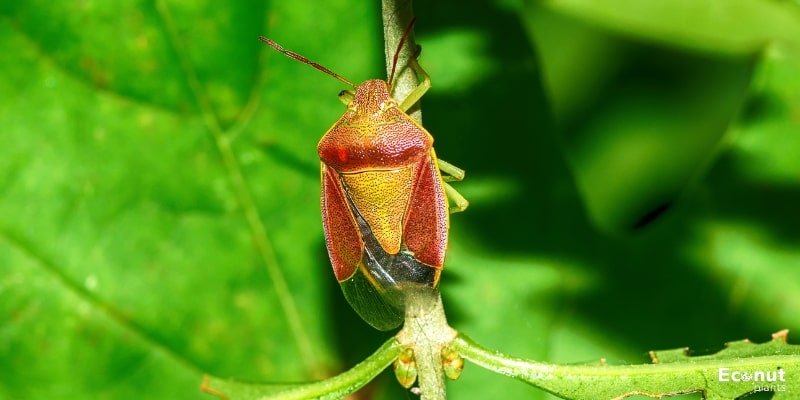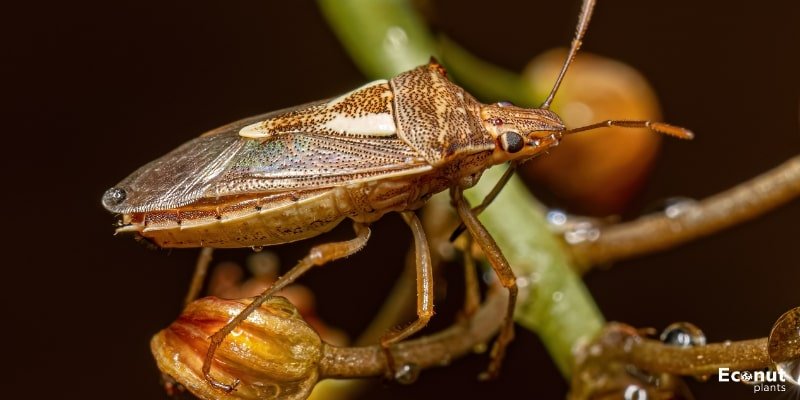Stink bugs come in a wide variety of forms and are widespread across the globe. The bad smell that these insects release from glands in their abdomens when they sense danger has given rise to their moniker. While many stink bug species are merely seen as bothersome pests, some have the potential to seriously harm agricultural goods like vegetables.
It would be easier for you to comprehend why stink bugs can be in your yard or house if you were aware of their various varieties. Here are some details about the most prevalent species that you might come across.
1. Blue Shield Bug

Although they are attractive enough to make one want to keep them around, these glossy insects of the Pentatomidae family are a nuisance in areas with low vegetation, such as meadows and forests.
Zicrona caerulea is found in areas of Britain and North America with limited tree cover. Its body is a shiny blue-green colour with black embellishments.
2. Red-Shouldered Stink Bug

A relatively recent pest discovered in Ohio on soybeans is the red-shouldered stink bug (fig. 5). It’s kind of like the red-banded stink bug, which is a big deal in the southern states. Though still dangerous, the red-shouldered stink bug does not inflict nearly the same damage as the red-banded stink insect. Green in color, adults typically have a reddish-pink stripe running across the pronotum, or “shoulder.”
However, this stripe is not always as noticeable. The apex of the triangle (scutellum) in adults may also have a pink marking. On its abdomen, between its hind legs, there is no spine. Nymphs have coloured stripes on their abdomen and dark red and black markings on their thorax, with the majority of them being white.
3. Black Stink Bug

Proxys punctulatus, the scientific name for the black stink bug, is less frequent in homes but yet has a big influence on agriculture. They are mainly black in appearance, with a metallic sheen occasionally. They harm fruits and vegetables severely and feed on a wide range of plants.
4. Green stink bug

Green stink bugs are green and orange in the early stages of growth. They get green on the body and black on the antennae as they mature into fully developed adults. Up to two millimeters can be the maximum length for green stink bugs. These are the kinds of pests that you might come across eating soybeans.
5. Southern green stink bug

These green stink bugs are native to Ethiopia and are now found all around the world. In the United States, they are typically found in warmer, more humid regions like Alabama, Florida, Georgia, and Hawaii. They are distinguished by the black dots on their green abdomen and are known to spread a plant disease that harms crops of beans and cotton.
6. Anchor Stink Bug

The characteristic anchor shape on the bottom of the shield makes Stiretrus anchorage rather easy to identify. They feed on crop pests and other insects and can be found on potatoes, soybeans, and pole beans.
7. Spined Soldier Bug

The spined soldier insect is a predaceous stink beetle that feeds on many pests found in all types of field crops. Its most distinguishing attribute is a long, pointed abdominal spine between its legs, although it normally has pointy shoulders.
The nymphs have black heads and a dark red colour. The subsequent instars have tan to orange colorations on their abdomens with red and white stripes.
Also Read: Insectivorous Plants
8. Brown stink bug

A brown stink bug’s nymph stage is when it turns light brown in colour. They turn yellow-brown as they mature. There is no abdominal spine in adult stink bugs. Brown stink bugs are primarily half an inch long and feed primarily on immature maize.
9. Conchuela Stink Bug

Though it should be simple in theory to distinguish between the two species, Chlorochroa ligata is difficult to identify because of its variable phases! They can be black with a red dot and shield outline or pale green with a yellow dot and outline. The “black” indeed looks black, but it’s actually a dark green.
The bottom of the shield on these stink bug species is crescent-shaped, and their shoulders are rounded. They can be found all over North America, and their peculiar diet consists of cotton, grapes, mesquite, mustards, peas, prickly pears, tomatoes, and yucca.
10. Rough stink bug

Rough stink bugs, also known as arboreal stink bugs or tree stink bugs, are a genus of stink bugs in the family Pentatomidae. They are commonly found in the United States and Canada and are known for their ability to spray a foul-smelling fluid when disturbed.
11. Black and Red Stink Bug

Cosmopepla lintneriana insects, also known as the twice-stabbed stink bug, are easily recognized by their distinctive black and red pattern and measure no more than 6 millimetres in length.
These insects have two red spots in the middle of their black shield, along with a red line and diamond at the top. They graze on mint, oat, and asparagus seeds and are distributed across North America and a small portion of Mexico.
12. Brown Marmorated Stink Bug

The marmorated stink bug is something you don’t want to see around. It’s so bad that it became a four-letter word, BMSB! Although Halyomorpha halys originated in eastern Asia, it has now spread throughout Europe, eastern North America, Australia, and Chile by feeding on imported products. Since they are a highly invasive species and spend the winter in buildings, you may find them in your house when the weather turns chilly.
At up to 17 millimetres in length, it is larger than the majority of stink bug species. Its five nymphal stages allow it a great deal of variety throughout its life cycle, despite having a mottled colouring of light and yellow-brown with red stripes and a white band around its legs and on its five-segmented antennae.
13. Dusky Stink Bug

Euschistus tristigmas, another mottled brown stink bug, can be difficult to identify, although it attempts to make it easier with its distinctively pointed shoulders and thin head. It is much more pointed than the brown marmorated stink bug, yet it has a similar coloring.
Recall that we mentioned that location frequently makes a difference? This particular species is quite selective, inhabiting apple, cherry, peach, pear, and plum trees in the eastern region of North America.
14. Mormidea Lugens

Along with Mexico and the Caribbean islands, this stink bug is primarily found in eastern North America, with a few reports in California. Its medium brown color and tan streaks on its back give the shield its rounded tip. Sedge, deer tongue grass, and timothy grass is just a few of the grasses that contain it.
15. Redbanded Stink Bug

The distinctive red band that runs around the sides and across the top of the shield gives these green stink bugs—Piezodorus guildinii—their name. However, because some of them don’t develop that useful identifier, it can be a little challenging to identify them. The shield’s tip ends in a rounded square edge known as a “squoval” point.
In Central and South America, this stink insect is a serious pest on vital agricultural crops. They are a big issue for soybean growers and can be found in the southern US on any sort of legume.

